Introduction to Docker Interview Questions
It pays to be as ready as possible for a docker job interview. You not only should have your cv and references in order, but you really should have a good understanding of the role and the organization. Researching the firm, for example, demonstrates to the interviewer that you are really interested in the company and have taken some time to do your study. However, you should brush up on the details of the position you’re applying for. If you’re seeking a position that depends heavily on Docker cloud technology, for example, you need to brush up on your Docker skills.
Docker is a software application for fast-developing, testing, and deploying applications. Docker organizes software into containers, which include everything the software requires to operate, such as modules, tools, code, and runtime. Docker allows you to swiftly deploy and grow apps in any environment while remaining certain that your code will execute. Docker on AWS gives developers and administrators a highly dependable, low-cost approach to building, deploying, and running distributed apps at any scale.
In this article on Docker Interview Questions. I’ll go over the most common and top Docker Interview Questions and answers.
Beginners Level Docker Interview Questions
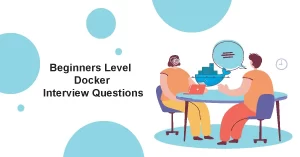
In this section, I’ll be covering the fundamental and basic Docker interview questions asked by the candidates. These Docker interview questions will help you ace the interview. Let’s get started.
Are you familiar with Docker?
This is one of the very basic docker interview questions. You will answer this question by defining docker.
Yes, Docker is a lightweight containerization solution that is open-source. Inside the cloud and applications packaging worlds, it has acquired a lot of attention. It enables the distribution of programs in lightweight and compact containers to be automated.
What is a container?
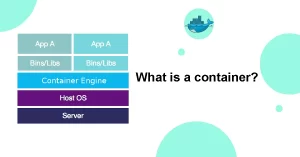
One of the basic docker Interview Questions. Containers are pre-configured apps that come with all of the required libraries and configuration files. The OS kernel is shared by all of the parts. The container may run on any system or in the cloud because it isn’t bound to any specific IT architecture.
Docker may be seen as a large ship (docker) transporting large crates of goods (containers). A Docker container does not need the installation of an additional operating system. Docker simply leverages the kernel’s resources and capabilities to allocate them for the CPU and memory. It employs resource isolation for CPU and memory, as well as different namespaces to segregate the application’s view of the OS (operating system).
What is containerization?
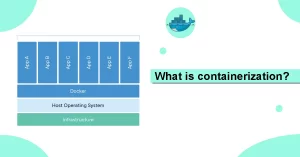
One of the basic docker Interview Questions and you can answer this question by illustrating this with an example. Because of dependencies, code written on one system may not operate flawlessly on another machine during the software development process. The containerization idea was used to tackle this difficulty. So, an application is packed and wrapped with all of its configuration files and dependencies as it is produced and delivered.
A container is a name for this bundle. When you want to execute the program on a different machine, you may use the container, which provides a bug-free environment because all the dependencies and libraries are wrapped together. Docker and Kubernetes are two of the most well-known containerization environments.
What is virtualization?
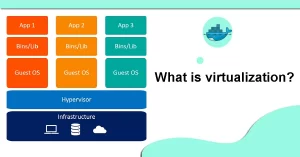
One of the basic docker Interview Questions. The process of generating a software-based, virtual replica of anything is known as virtualization (compute storage, servers, application, etc.). A single hardware system is used to produce these virtual versions or settings. Virtualization allows you to divide a single system into many pieces that function as separate, independent systems. This type of splitting is feasible thanks to a program called Hypervisor. The hypervisor’s virtual environment is referred to as a Virtual Machine.
What is Hypervisor?
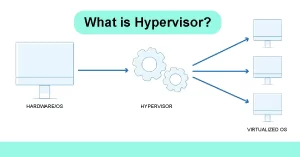
A hypervisor is a piece of software that enables virtualization. Virtual Machine Monitor is another name for it. It splits the host system into virtual environments and assigns resources to each one. On a single host machine, you can practically run many operating systems. Hypervisors are divided into two categories:
Type 1: This hypervisor is also known as a native hypervisor or a bare-metal hypervisor. It runs on the core host system directly. It doesn’t need a base operating system because it has access to the host’s system hardware.
Type 2: The core host operating system is used by this type of hypervisor. Hosted Hypervisor is another name for it.
Difference between virtualization and containerization
To answer this docker Interview Questions, just explain the points of both as stated below:
|
Virtualization |
Containerization |
|
This enables developers to execute and host numerous operating systems on a single physical server’s hardware. |
This allows developers to run numerous programs on a single virtual machine or server while utilizing the same operating system. |
|
Hypervisors enable guest operating systems with overall virtual machines. |
Containers guarantee that programs are operated in an isolated environment/userspace. Changes made within the container have no effect on the host or even other containers belonging to the same host. |
|
Each virtual machine on the host operates as a physical machine because these virtual machines abstract the system hardware layer. |
Containers abstract the application layer, implying that each container represents a separate application. |
What is a Dockerfile?
These are basic docker interview questions. Let’s start with a brief overview of Dockerfile. Docker can read instructions from a document named Dockerfile and generate images for you automatically. A Dockerfile is a file that contains all of the commands that a user may use to create an image from the command line. Users may use docker build to develop an automated build that runs a series of command-line instructions in order. The interviewer isn’t looking for definitions alone, demonstrating how to use a Dockerfile, which comes with expertise.
Please tell us about Docker Compose
Docker Compose is a YAML file that includes information on the Docker application’s services, networks, and volu
mes. As a result, you could use Docker to construct several containers, host them, and have them interact with one another. Each container will include a port that may be used to communicate with other containers.
What is a docker image registry?
In basic words, a Docker image registry is a location where docker images are kept. Rather than converting apps to containers each time, a programmer can use the images saved in the registry directly. This image registry could be public or private, with Docker Hub being the most well-known and well-known public registry.
How many Docker components are there?
Docker Client, Docker Host, and Docker Registry are the three docker components.
|
Docker Client |
Docker Host |
Docker Registry |
|
This component executes “build” and “run” activities with the Docker host in order to establish communication. |
This component contains the primary Docker daemon and hosts containers and images. The daemon connects to the Docker registry. |
The Docker Registry is where the Docker images are stored. There might be a public or private register. Docker Hub and Docker Cloud are two of the most well-known public registries. |
Intermediate Level Docker Interview Questions
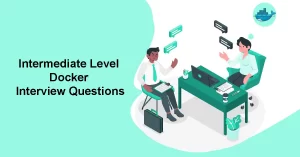
In this section, I’ll be covering the intermediate Docker interview questions asked by the candidates. These Docker interview questions will help you ace the interview. These docker interview questions are asked if you clear the beginner questions. These questions are asked with the motive of measuring how much knowledge and skill you have for that specific technical skill. Let’s get started with intermediate docker interview questions.
Name the fundamental Docker commands and what is their usage?
The following are the most important Docker commands:-
|
Build |
Commit |
Create |
Dockerd |
Kill |
|
Constructs a Docker image file. |
Creates a new image based on changes to the container. |
his function creates a new container. |
Docker daemon is started |
This command Kills a container |
What is Docker Swarm?
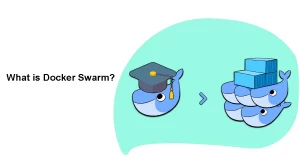
Docker Swarm is a key notion in Docker, thus you should be familiar with it. Docker Swarm is Docker’s native clustering solution. It combines many Docker hosts into a single digital Docker host. Docker Swarm implements the standard Docker API, allowing any program that already connects with a Docker daemon to scale across several hosts transparently.
What is a Docker Container’s lifecycle?
One of the most commonly asked questions asked in Docker interviews is this one. The lifespan of a Docker container is as follows:-
- Construct a container.
- Activate the container.
- The container will be paused (optional)
- Restart the container (optional)
- Begin filling the container
- Put a stop to the container.
- Start the container again.
- Destroy the container by killing it.
Is it possible for a container to restart on its own?
Yes, but only when specific docker-defined rules are used in conjunction with the docker command line. The policies that are accessible are as follows:-
- Off: If the container is stopped or fails, it will not be resumed.
- On-failure: In this case, the container restarts itself only if it encounters failures unrelated to the user.
- Unless stopped: This policy assures that a container may only resume when the user issues a command to stop it.
- Always: In this form of policy, regardless of failure or stoppage, the container is always resumed.
Describe the differences between Docker and alternative container technologies.
Docker is a new container technology that has quickly become the most popular. Docker is a cloud-native container platform with a slew of new capabilities that prior container technologies lacked. One of Docker’s best benefits is that it can operate on any infrastructure, including your own computer and the cloud.
More apps can now operate on the old servers thanks to Docker, which significantly simplifies the process of packaging and shipping programs. Docker also features a Container Hub, which serves as a library for easy-to-download-and-use containers. Furthermore, your apps can share these containers. It also has a lot of documentation, which makes it superior to competing container technologies.
Will you lose your data if you depart the Docker Container?
When a Docker is closed, no data is lost since the program writes all of the data to disc for the express purpose of preservation. This step is done indefinitely until the container is unambiguously eliminated. Furthermore, the Docker container’s file system survives long after the Container instance is stopped.
How is Docker monitored in production?
Docker stats and Docker events are tools that may be used to monitor Docker in production. These tools allow users to obtain reports on crucial statistics. When Docker starts is called with a container ID, it delivers the CPU and memory utilization of the container. It’s comparable to Linux’s top command. Docker Events, on the other hand, are commands that display a list of Docker Daemon actions in progress. Attached, commit, rename, destruct, die, and other occurrences are among them. Filtering the events one is interested in is also an option.
Provide some insight into the Docker workflow.
You can answer these basic docker Interview Questions like this. The following is a quick rundown of the Docker workflow:-
- Everything starts with the Dockerfile because it is the image’s source code.
- The Dockerfile is being used to produce the container image after it has been built. Only the compiled variant of the Dockerfile is included in this image.
- This image is then disseminated via the registry, which functions as an image repository.
- The picture can also be used to launch containers. While operating, a container is remarkably similar to a virtual machine (VM) without the hypervisor.
Explain why the commands ‘Docker run’ and ‘Docker creates’ are different.
The main distinction between Docker run and Docker creates is that the latter creates the container in a ‘stopped’ state. Docker may also be used to save and output container IDs for later usage. It’s preferable to use ‘do
cker run’ with —cidfile FILE NAME since running it again won’t enable you to overwrite the file.
In a Dockerfile, what is the difference between CMD and ENTRYPOINT?
Both the CMD and ENTRYPOINT commands in a Dockerfile specify that command will be performed while a container is operating. There are various ground rules for their collaboration, such as
- CMD or ENTRYPOINT should be specified in the Dockerfile.
- ENTRYPOINT must be defined when utilizing the container as an executable.
- CMD will be overridden if you execute the container with an alternate parameter.
Advanced Level Docker Interview Questions
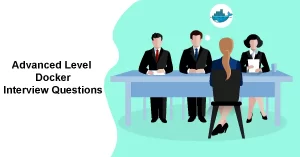
In this section of Docker interview questions, I have covered the following advanced level Docker Interview Questions and answers.
How can You access the Docker repository?
These docker interview questions are asked because they test how much experience you have with that tool. To answer these docker questions be specific to the point and follow steps.
To log into hub.docker.com, use the following command: $ docker login
You’ll be asked for your login details, which you should provide, and then you’ll be signed in.
Which technique is the more effective for destroying a container: “stop container” followed by “remove the container,” or the rm command alone?
First, stop the container, then remove it. Here’s how to do it:-
- $ docker stop
- $ docker rm -f
How do you push an image to Docker Hub once you’ve worked with it?
These docker interview questions are asked because they test how much experience you have with that tool. This command is used to push an image to Docker Hub:- $ docker push <username/image name>
How do You create a Dockerfile?
After you’ve prepared a Dockerfile, you’ll need to build it in order to construct an image that meets those requirements. To create a Dockerfile, run the following command: $ docker build
When the dockerfile exits in the same file directory, use “.dockerfile name,” and if it exists someplace else, use the whole path.
Where do you believe Docker is utilized the most?
Docker is used in the following applications:-
- Docker simplifies setup by allowing you to codify and deploy your environment and settings.
- Developer Productivity: Using Docker for development brings us closer to production and allows us to build our development environment faster.
- Application Isolation: Your apps are separated since containers are applications wrapped along with all dependencies. They can run independently on any Docker-compatible hardware.
- Docker supports a number of debugging tools that aren’t specifically for containers but do function well with them.
- Docker reduces the time it takes to install a whole OS by eliminating the requirement to start from scratch.
Note: You Must Also Know About OBIEE Interview Questions , Excel Interview Questions , iOS Interview Questions
Conclusion
DevOps technologies are exploding in popularity. Because of the necessity to build software quicker and manage it better as systems become more dispersed, developers have resorted to containerization. They also constantly make integration and deployment easier and faster, therefore these technologies have exploded in popularity. I hope this article has provided you with a better understanding of the different sorts of docker interview questions and how to answer them.
Frequently Asked Questions
1. What are the features of Docker?
Docker comes with a number of features, some of which may be listed and explained further below.
- Configuration is faster and simpler.
- Isolation of applications.
- Productivity increases.
- Swarm. sServices.
- Mesh for routing.
- Management of security.
- Systems can scale up quickly.
Read more on this blog of Docker Interview Questions
Docker is a containerization platform that is free and open source. It allows developers to bundle programs into containers, which are standardized executable components that combine application source code with the OS libraries and dependencies needed to run that code in any environment. Read more on this blog of Docker Interview Questions.
A Docker image is a template that gives instructions for building a Docker container. It gives you a simple method to package up apps and pre-configured server environments, which you can also keep private or share with other Docker users.
4. What Docker is my image running?
You may check the status of the docker using the command systemctl status docker. Instead of systemctl, you may use systemctl start docker to get started. You can also try service, service docker status, and service docker start. Read more on this blog of Docker Interview Questions.
5. What is Docker architecture?
Docker is a container architecture. Docker is built on a client-server model. The Docker client communicates with the Docker daemon, which handles the construction, execution, and distribution of your Docker containers. You can execute the Docker client & daemon on the same machine, or you can link a Docker client to a Docker daemon that is located elsewhere.Read more on this blog of Docker Interview Questions.
6. What is detached mode in Docker?
Detached (-d) mode in Docker:- This implies we may start the container and utilize the console for additional commands once it has started. The container is running in the foreground of your terminal. It doesn’t take any input or produce any output. Read more on this blog of Docker Interview Questions.
7. What is the format of Docker image?
Based entirely just on Docker Image Manifest Version 2, Schema 2 format, the OCI format is a standard for container images. OCI images may be pushed and pulled using Container Registry. Read more on this blog of Docker Interview Questions.
8. What is Docker in simple words?
Docker is a tool for developing and deploying applications. It is built on the concept of packaging your code and dependencies into a deployable unit known as a container. For more information, read this blog on Docker Interview Questions.
9. Does Docker image contain OS?
The OS is not packaged up in Docker containers. They bundle the programs with everything they require to function. The engine is placed on top of a host’s operating system. Containers share the OS kernel, allowing several containers to execute on a single host. For more information, read this blog on Docker Interview Questions.
10. Will you lose data when Docker container exits?
Not in the least! Until you expressly destroy the container, all data that your program writes to the disc is retained in its container. For more information, read this blog on Docker Interview Questions.
11. What are the three main Docker components?
The Docker Engine is made up of three parts:-
- Server: Dockerd is the name of the docker daemon. It has the ability to generate and manage Docker images. Containers, networks, and so forth.
- The Rest API is used to tell the Docker server what to perform.
- CLI (Command Line Interface): It’s a client that allows you to run Docker commands.
For more information, read this blog on Docker Interview Questions.














One response to “25+ Docker Interview Questions | DataTrained”
[…] Also Read: Most asked interview questions on Docker Files […]